It has been about 10 years since I bought my first oscillating multi-tool, a Ryobi that I’ve used mostly for sanding in tight spaces and not much else; it’s a hobbyist’s tool. Last year I acquired (see the footnote at the end of this article for how) a DeWalt DCS356 Atomic 20V MAX multi-tool, a heavy-duty tool for more arduous work. The first time it proved its worth was when my furnace gave up the ghost last winter and I had to cut away a section of wall to have it removed and replaced. It cut through drywall quickly with minimal dust and cut through 2×4 framing in a space too small for any other saw. More recently, I’ve been using the multi-tool to repair and restore a Bolger pirogue. I’m doing the work in the backyard and every task is easier without having electrical cords in the way.
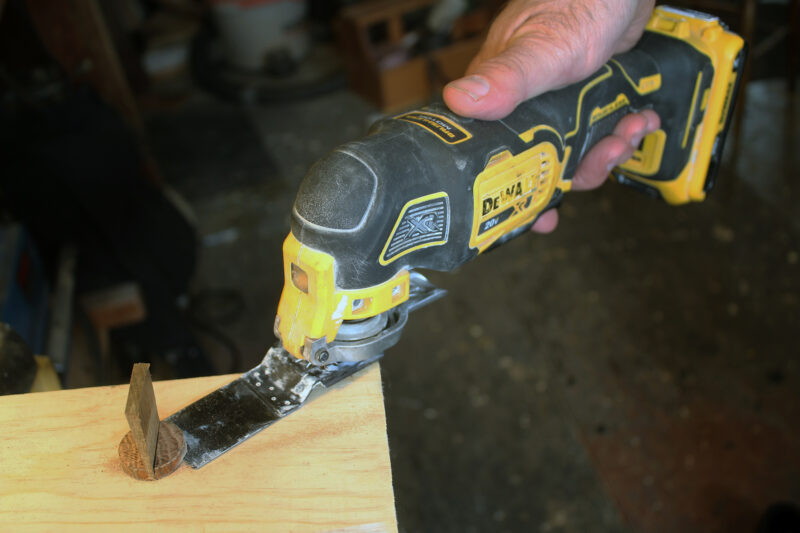 Photographs by the author
Photographs by the authorMost multi-tool blades are offset to make flush cuts possible. The DeWalt muti-tool got through this 1″ oak dowel in 8 seconds. It took me 14 seconds with my Japanese kugihiki flush-cut saw.
The DCS356 is a cordless version of the DeWalt DWE315. It’s powered by a 20-volt battery and has a brushless motor. The tool, without battery, weights 2 lbs 4.8 oz. It has a switch in its base for three speed ranges, and within each setting, the tool’s trigger has variable speed. The top speed is 20,000 oscillations per minute. A soft pull on the trigger turns a light on at the front of the tool, illuminating the work area. The light goes off 20 seconds after the trigger is released. The trigger has a lock, which comes in handy in tight quarters when it’s not possible to hold the tool with a finger on the trigger.
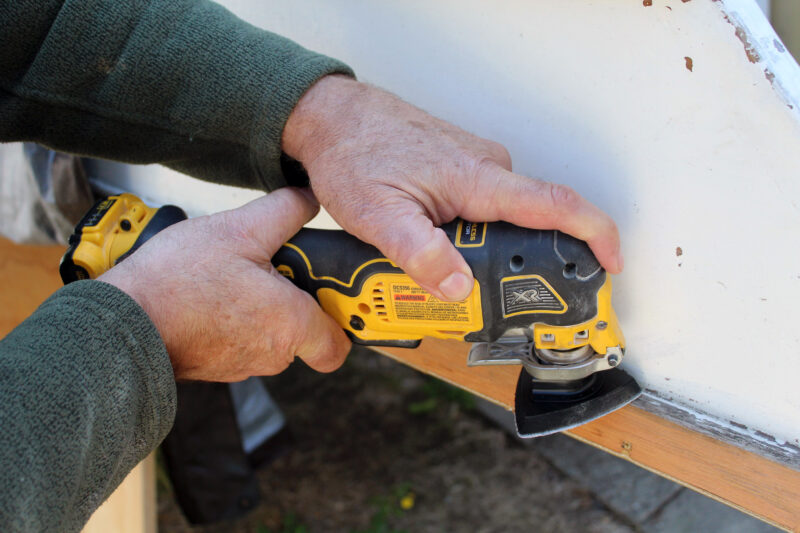
Equipped with a sanding pad and hook-and-loop sandpaper, the multi-tool is well-suited for getting into sharp corners.
The business end of the multi-tool has a spring-loaded quick release for installing and removing blades. Universal blades, designed to fit a wide variety of oscillating multi-tools, are slotted and slip into place before getting locked in position. For blades without slots, there is a threaded hole to attach them with a machine screw. The blades and other accessories can be positioned at various angles to the tool to best suit the work.
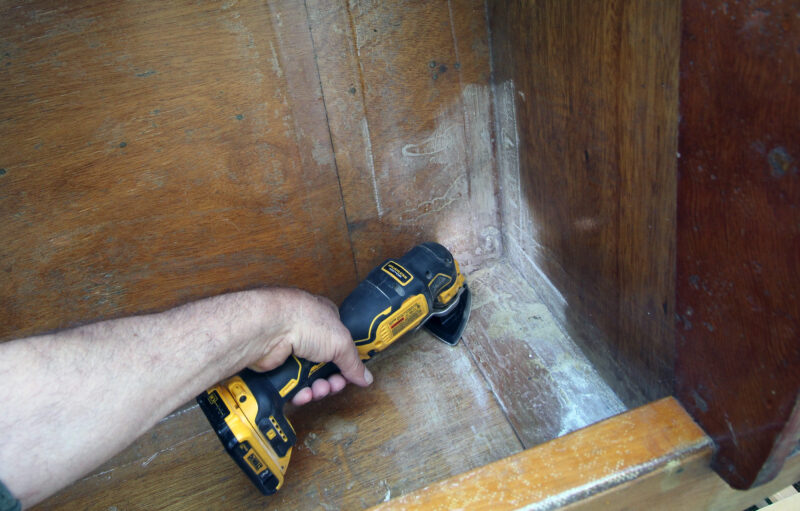
The built-in light effectively illuminates work areas.
Neither the DeWalt website nor the tool’s manual specify the oscillation arc for the DCS3536, but many retailers list it as 1.6°. The angle I measured was 3.5° to 4°. At the cutting end of the blade the length of that arc is about 4mm, which makes a difference for wood-cutting teeth that are about 2mm apart. I don’t think a movement of just 1.6°—with an arc length not quite 2mm—would cut effectively. With one of the high-carbon-steel wood-cutting blades I sawed through a 1″ oak dowel in eight seconds and with a bimetal blade for metal I cut through a 1⁄4″ steel machine screw in about one minute.
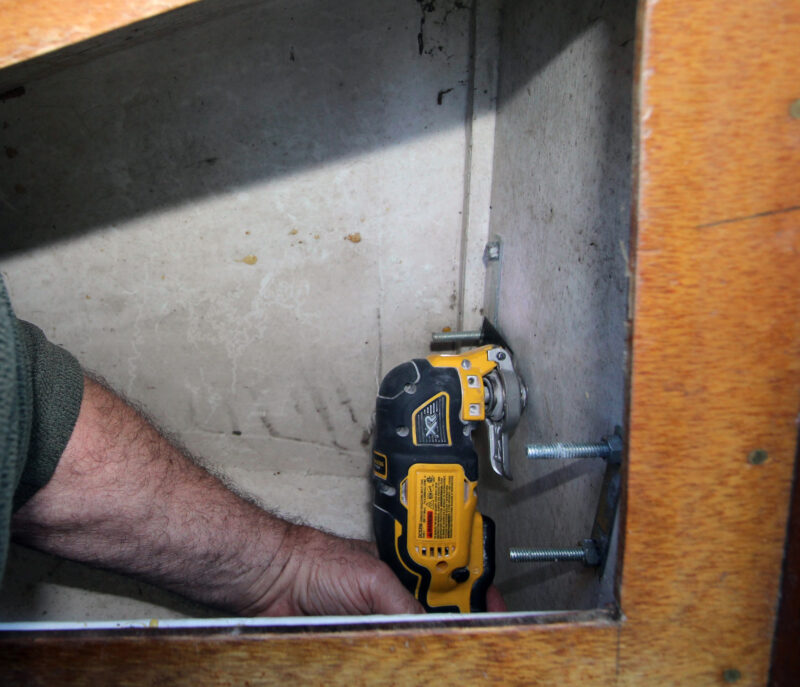
The blades can be set at different angles to accommodate tight workspaces. To cut off long bolt ends in this storage compartment, I could lock the trigger to keep the tool running while I changed my grip to a less awkward position.
The 20-volt 2Ah has plenty of long-lasting power. Its back end has a state-of-charge indicator with three lights that come on with the push of its button. When there’s only one light left, the battery is down to 25% charge. The indicator works even if the battery is not connected to the tool. The lithium-ion battery has a charge time of 35 minutes and weighs 12.5 oz. There are larger batteries with longer run times but they’re heavier. I haven’t felt the need for one.
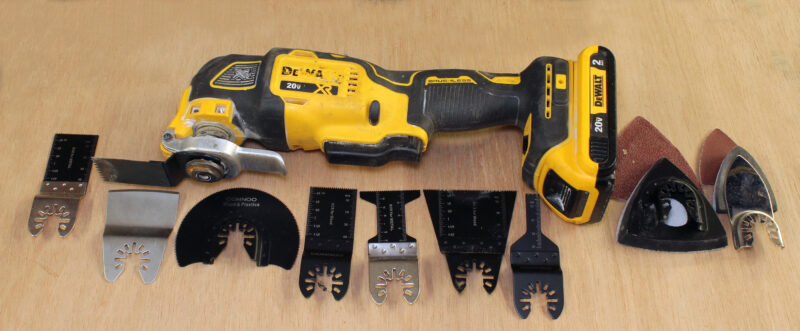
The quick-release device on the DeWalt DCS356 Atomic works with universal multi-tool blades that have slotted attachment points. It’s a real time-saver over the bolt-on system of early multi-tools.
The assortment of attachments I bought for the DeWalt includes 10 types of saw blades for wood, chisel-edged scraper blades, and two sanding pads with precut abrasive patches. There are carbide- and diamond-grit blades for other materials. I’ll buy more blades as I find other jobs that the DCS3536 multi-tool can do more easily or faster than any other tool in my shop.![]()
Christopher Cunningham is editor of Small Boats.
The DCS356 Multi-Tool from DeWalt sells for around $91 for the tool only and can be purchased as a kit with charger, battery, and accessories for $179. Prices vary with other retailers.
Is there a product that might be useful for boatbuilding, cruising, or shore-side camping that you’d like us to review? Please email your suggestions.
Stolen tools
My pickup truck was stolen a year ago and was missing for about a month until I got a call from a police officer some 35 miles away: the truck had been located and I could retrieve it. The cab and the bed were chock-full messes, and it was evident that the thief had been using the truck to steal tools from construction sites. The officer I met at the scene said I could do as I pleased with whatever was in the truck. None of the tools had any marks to identify the owners. I searched for their serial numbers on Stolen Register and Power Tool Safe and none of the tools I’d acquired had been registered as stolen. If the owners had recorded the serial numbers, they could have registered them at these websites, and I could have returned their tools. —CC






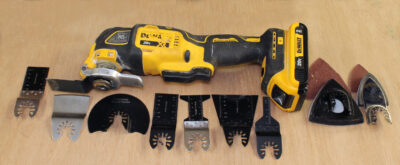



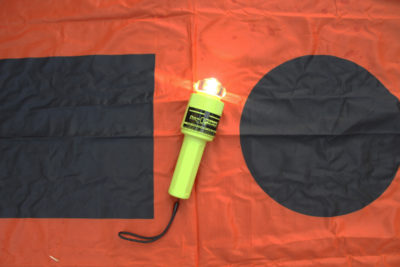

Join The Conversation
We welcome your comments about this article. If you’d like to include a photo or a video with your comment, please email the file or link.